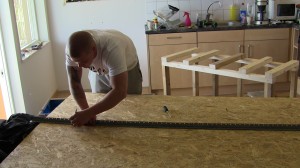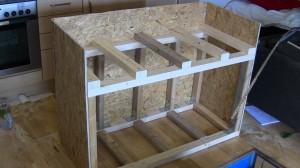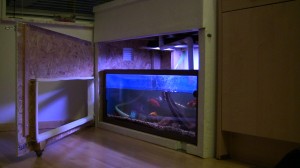|
Uppsala Aquaponics was started as a course project by Isabel Enerson and Julia Fiore at Uppsala University of Sweden in 2012. I met Julia in a sustainable development class, and we started talking about aquaponic systems. When the semester was over she told me she wanted to show me something. I followed her to a greenhouse where she showed me their own aquaponic system, and since they were soon heading back home to the US, she asked me if a wanted it. I accepted!
However the system was too big to fit in the car so we had to saw off its legs in order to get it in. What was even worse was that we couldn’t even get it through my apartment door horizontally, so we had to tilt it vertically, which means we had to empty whatever was already planted. And when we put the content in boxes, the wet gravel and leca pellets wetted down the bottom of the boxes.. and even though we tried to hurry, of course the last box broke on the last step of the stairs that leads up to my apartment. The fish tank also belonged to the university.
So here I was with an unstable and sawed-off grow bed, no plants, no fish tank, gravel and leca pellets all over my neighborhood and apartment, no oxygen pump for the fishes whom I temporarily had put in a baby pool in which I had to change the water every fourth hour.
My brother asked me: ”Either You give up on the whole idea right now, or I help You until it’s finished”. Picking up on the offer I said ”Let’s do it!” and the team was formed.
So my brother Joakim was assigned with leadership. He designed, planned and worked most of all during the project. Other family and friends members joined in and helped out with tools, transportation, work and support and with that kind of warm people around oneself, it was only fun to work and bound-strengthening to do it in a team. So let me show you how we did this:
We started off with taking apart all of the screws and wooden joists so that we were free to rebuild the system in whatever fashion we’d like. Then we spent lots of time on planning, drawing the blueprints and adding more components. Though I managed to find a sweet deal via an advert on an aquarium including all that’s needed for the fishes to have a nice little home, and that extra joists were actually given to us from my brothers’ employers, this still required some shopping. This planning, drawing and shopping kept developing during the process of actual carpentering and evaluating.
From Isabel and Julia we got fishes, joists, rubber tablecloth , water pipe, strainer tube, gravel and leca (light expanded clay aggregate), water pump and hose. So now screws, nails, white paint, filler, gratings, hooks, hinges, doorknob, door wheel, hose holder, brackets , sheet metal moldings, OSB’s ( orientated strand boards), light armature, more fishes and foam rubber was gathered. With a saw and tin shears we chopped up all the wood joists, OSB’s and sheet metal moldings in desirable shapes and sizes. Then we screwed the joists together (with gravitation in consideration) in a stable structure so that a joist closer to the earth or floor supports the weight of another resting on top of it, putting brackets on each side of every joist standing vertically (see image below to the right).

Klick on images for larger view |
 _ _ |
The system could be separated into two parts: the grow bed (upper body) and the fish home (lower body). Next up was attaching the OSB’s as side walls and front door. On the grow bed we obviously had to make walls covering all four sides so no water will run out, however, on the lower body we left the back open since it’s facing the wall and won’t be visible while it contributes to a better ventilation inside the furniture. This is also why we cut out squares from the side walls and added gratings for even higher ventilation. But before that was done the sides had to be filled and painted. On the door ,which is the lower body’s front side, we cut out a big rectangle the same size as the glass of the aquarium, displaying the fishes daily life to the outside world. Along the corners and top of the sides and front and ”aquarium frame” that had now been created from the cut out rectangle, we placed the sheeted metal moldings to cover and flatten the surface. This part was filled and painted before it was attached to the furniture because we wanted to keep the metal ”color” of the hinges, knob and the hook.
The bottom of the grow bed is a wooden board resting on the joists to give a plain surface, stroked out on it is a water proof rubber tablecloth that is nailed and screwed on so that it covers the whole inside of the grow bed. A water pipe is penetrating the board and the rubber tablecloth through a hole made so tight and caulked that no gap is allowed to let water through. An improvised water pipe hanger and light armature holder were installed with OSB left overs screwed on to joists to keep the pipe from dropping into the aquarium. More of those left overs were also used as moldings to cover the rubber tablecloth to give the furniture a nicer look.
Moving on, the door was attached by two hinges to the lower body. On the inside of the door, the sheeted metal moldings were jutting out a little bit so we placed foam rubber strips along these, just in case so that if someone would slam the door and the metal would reach the aquarium window, there will be an airbag there to soften the impact. Underneath, on the opposite side from the hinges we attached a small wheel on to the door so that we can now open and pull it up without having to lift it since it is resting and rolling on the wheel.

Now there were only details left. We put the door hook, doorknob and hose holder in place, placed the aquarium inside the lower body, put the water pump in the aquarium, pulled the hose from the water pump up to the grow bed and filled the grow bed with gravel that plants may take root in, and leca pellets that float in the water and keeps plants from sinking while it also provides thermal insulating. We give the fish food and plug in the water pump. The aquatic effluents that accumulate in aquaculture travel through the water pump and hose up to the grow bed where the plants pick them up as nutrients, sending back clean water down to the fish through the strainer tube and pipe.
So the only thing we have to do now is keep the fish happy and adjust the value of pH in the aquarium so that it is between 6 and 8 (some plants grow better closer to 6 and some like it better closer to 8), easy to check with pH-tests and adjust with pH+/- from pet stores. Many people might think that aquaponics is something for your backyard or green house only, but please check our construction out in the video below where we’ll show you how to make it fit beautifully in a modern apartment.
|